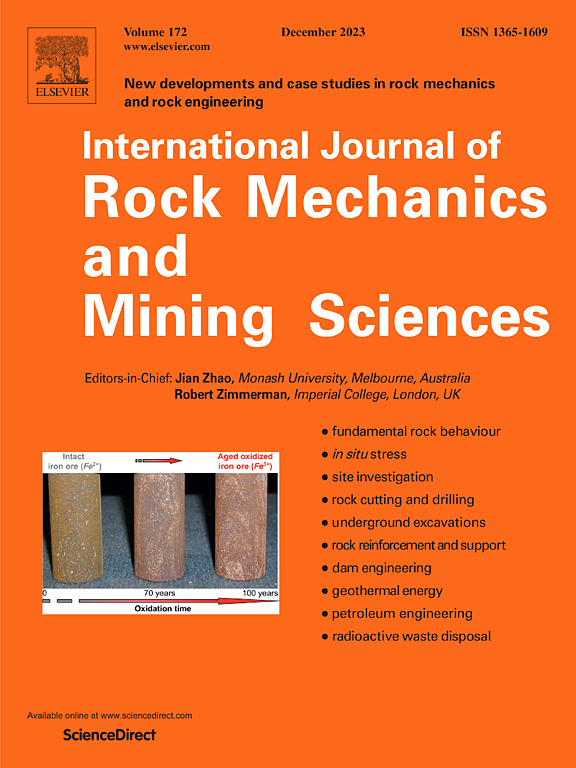真三轴应力和热条件下岩性对比对页岩弹性各向异性的影响
IF 7
1区 工程技术
Q1 ENGINEERING, GEOLOGICAL
International Journal of Rock Mechanics and Mining Sciences
Pub Date : 2025-04-03
DOI:10.1016/j.ijrmms.2025.106100
引用次数: 0
摘要
页岩具有复杂的微观结构,包括矿物排列和层理方向等,其固有的各向异性显著影响地震波传播,影响地下成像和储层表征。尽管对页岩各向异性进行了广泛的研究,但在真三轴条件下使用立方试样进行的研究仍然有限,该研究可以提供更真实的地下应力状态模拟。本研究利用多轴加载装置研究了印度Jharia盆地下Gondwana二叠系Barakar组两种不同页岩岩性:灰色页岩(GSH)和粉质页岩(SSH)在不同的等静压(8 MPa、12 MPa、25 MPa、35 MPa和51 MPa)和温度(20°C、50°C、100°C、150°C和200°C)下的弹性各向异性行为。纵波速度(Vp)和横波速度(Vs)在多个方向(平行、垂直和与层理平面45°)进行测量,以便对弹性特性进行综合评估。结果表明,随着等静压的升高,Vp和Vs均显著增大,表明微裂纹和孔隙的闭合导致了刚度的增强。此外,与SSH相比,GSH始终表现出更高的波速,这归因于其更高的石英含量和矿物排列,这有助于减少剪切波分裂。动态体积模量(K)分析表明,两种页岩类型的动态体积模量(K)都随着压力的增加而增加,与SSH中观察到的非线性行为相比,GSH表现出更线性的响应,这是受其富含粘土成分的影响。温度引起的弹性特性变化很小,在恒定压力下,在较高温度下观察到的波速只有轻微的下降,这推断了页岩结构的稳定性。这种稳定性表明,在测试温度范围内,热膨胀和矿物转变对这些页岩的弹性行为没有显著影响。此外,Thomsen各向异性参数(ε和γ)在不同压力和温度条件下表现出明显的趋势,随着压力的增加,各向异性总体上降低,反映了随着原有微裂纹的关闭,各向同性行为的转变。该研究提供了对两种不同页岩岩性弹性性质变化的基本认识,为地下资源开发策略提供了支持,强调了在真三轴条件下使用立方试样精确模拟地下应力状态的重要性。本文章由计算机程序翻译,如有差异,请以英文原文为准。
Influence of lithological contrast on elastic anisotropy of shales under true-triaxial stress and thermal conditions
The intrinsic anisotropy of shales, arising from their complex microstructure, including mineral alignment and bedding orientation, significantly influences seismic wave propagation, impacting subsurface imaging and reservoir characterization. Despite extensive research on shale anisotropy, studies employing cubic specimens under true-triaxial conditions, which provide a more realistic simulation of subsurface stress states, remain limited. This study investigates the elastic anisotropic behaviour of two distinct shale lithotypes: grey shale (GSH) and silty shale (SSH) from the Permian Barakar Formation of Lower Gondwana in the Jharia Basin, India, under varying isostatic pressures (8 MPa, 12 MPa, 25 MPa, 35 MPa, and 51 MPa) and temperatures (20 °C, 50 °C, 100 °C, 150 °C, and 200 °C) using a polyaxial loading apparatus. Compressional (Vp) and shear wave (Vs) velocities were measured in multiple orientations—parallel, perpendicular, and at 45° to the bedding plane—allowing for a comprehensive evaluation of elastic properties. The results reveal that both Vp and Vs exhibit a noticeable increase with rising isostatic pressure, indicating enhanced stiffness due to the closure of microcracks and pores. Moreover, GSH consistently demonstrated higher wave velocities compared to SSH, attributed to its higher quartz content and mineral alignment, which contributed to reduced shear wave splitting. The analysis of dynamic bulk modulus (K) indicated a consistent increase with pressure for both shale types, with GSH exhibiting a more linear response compared to the non-linear behaviour observed in SSH, influenced by its clay-rich composition. Temperature-induced changes in elastic properties were minimal, with only slight decrease in wave velocities observed at higher temperatures under constant pressure, inferring to the stability of the shale structure. This stability suggests that thermal expansion and mineralogical transformations do not significantly impact the elastic behaviour of these shales within the temperature range of the test. Furthermore, Thomsen anisotropy parameters (ε and γ) exhibited distinct trends under varying pressure and temperature conditions where overall a reduction in anisotropy was observed with increased pressure, reflecting a transition to more isotropic behaviour as pre-existing microcracks closed. The study provides a baseline understanding of variations in elastic properties of two different shale lithotypes to support subsurface resource exploitation strategies, underscoring the significance of employing cubic specimens under true-triaxial conditions to accurately simulate subsurface stress states.
求助全文
通过发布文献求助,成功后即可免费获取论文全文。
去求助
来源期刊
CiteScore
14.00
自引率
5.60%
发文量
196
审稿时长
18 weeks
期刊介绍:
The International Journal of Rock Mechanics and Mining Sciences focuses on original research, new developments, site measurements, and case studies within the fields of rock mechanics and rock engineering. Serving as an international platform, it showcases high-quality papers addressing rock mechanics and the application of its principles and techniques in mining and civil engineering projects situated on or within rock masses. These projects encompass a wide range, including slopes, open-pit mines, quarries, shafts, tunnels, caverns, underground mines, metro systems, dams, hydro-electric stations, geothermal energy, petroleum engineering, and radioactive waste disposal. The journal welcomes submissions on various topics, with particular interest in theoretical advancements, analytical and numerical methods, rock testing, site investigation, and case studies.

 求助内容:
求助内容: 应助结果提醒方式:
应助结果提醒方式:


